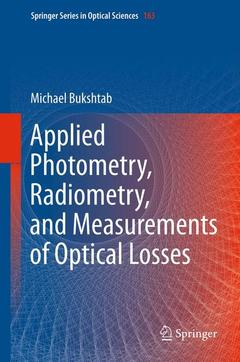Applied Photometry, Radiometry, and Measurements of Optical Losses, 2012 Springer Series in Optical Sciences Series, Vol. 163
Auteur : Bukshtab Michael

Applied Photometry, Radiometry, and Measurements of Optical Losses reviews and analyzes physical concepts of radiation transfer, providing quantitative foundation for the means of measurements of optical losses, which affect propagation and distribution of light waves in various media and in diverse optical systems and components. The comprehensive analysis of advanced methodologies for low-loss detection is outlined in comparison with the classic photometric and radiometric observations, having a broad range of techniques examined and summarized: from interferometric and calorimetric, resonator and polarization, phase-shift and ring-down decay, wavelength and frequency modulation to pulse separation and resonant, acousto-optic and emissive - subsequently compared to direct and balancing methods for studying free-space and polarization optics, fibers and waveguides. The material is focused on applying optical methods and procedures for evaluation of transparent, reflecting, scattering, absorbing, and aggregated objects, and for determination of power and energy parameters of radiation and color properties of light.
Acknowledgements.- Abstract.- Preface.- PART I APPLIED PHOTOMETRY AND RADIOMETRY.- I.1. Background.- Chapter 1 Radiometric and photometric quantities and notions.- Chapter 2 Methods of photometric and radiometric measurements.- Chapter 3 Radiometry of partially coherent radiation.- Chapter 4 Photometers and radiometers.- PART II MEASUREMENTS OF OPTICAL LOSSES.- II.1. Features of low-loss assessments.- Chapter 5 Conventional measurement techniques.- Chapter 6 Systems of multiple reflections.- Chapter 7 Laser spectroscopy.- Chapter 8 Measurements in passive resonators.- Chapter 9 Determination of absorption losses.- Chapter 10 Direct attenuation measurements.- Chapter 11 Propagation losses in fibers and waveguides.- References.
Michael A Bukshtab received M.S. and Ph.D. degrees in “Optical Design and Spectroscopy” and in “Physical Optics” from The Technical University of Fine Mechanics & Optics and from The Vavilov’ State Optical Institute, and had post-doctoral tenure analyzing high-purity silica glasses and specialty fibers in The Institute of Silicate Chemistry, Academy of Sciences - all in St. Petersburg (Leningrad), Russia. His M.S. thesis received the Best Diploma award among nearly 30 Leningrad technical universities and was published in “Measurement Techniques” in 1978. Michael’s monograph “The Low Loss Measurement Techniques”, 165 pages, was published in 1988 by Energoatomizdat, Moscow-Leningrad. Another book: M.A. Bukshtab, A. S. Doynikov, and V. N. Koromislichenko, “Photometry and Radiometry for Engineers” (editors M. A. Bukshtab and A. A. Wolkenstein) by Polytechnika, Leningrad (St. Petersburg), 1991, was announced for publication, book proofs were printed, but manuscript was left unpublished, as Michael immigrated to the USA. Michael was elected by employees the Board Chairman of Leningrad’s Institute of Telecommunications, where he served from 1989 until immigrating in 1991. In USA Michael worked on design, development, and fabrication of optical systems and components for such companies as Sandoz, Corning, Pirelli, Kodak, CIENA, Lucent, and GE Advanced Materials. Michael latest experience via Michael A Bukshtab Consulting includes designing complex systems and components and investigating various optical properties -measurement of color-shifting, polarization-dependent, backreflection, backscattering and other low-loss related phenomena, designing all-optical wavelength-switching and cross-connect systems and OADM networks, working on terabit optical routers and optical backplanes, investigating EUV lithography systems, interferometric and diffraction-based positioning sensors, improving fiber-laser and EDFA-based air-to-groundranging lidars. Michael has autho
Date de parution : 01-2012
Ouvrage de 712 p.
15.5x23.5 cm



